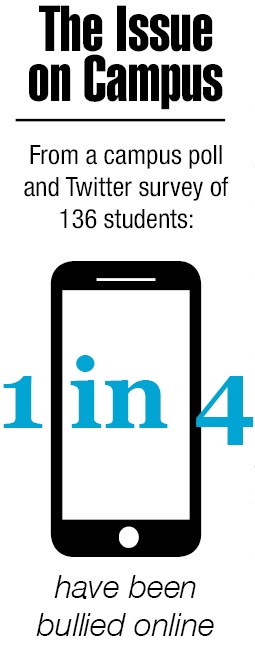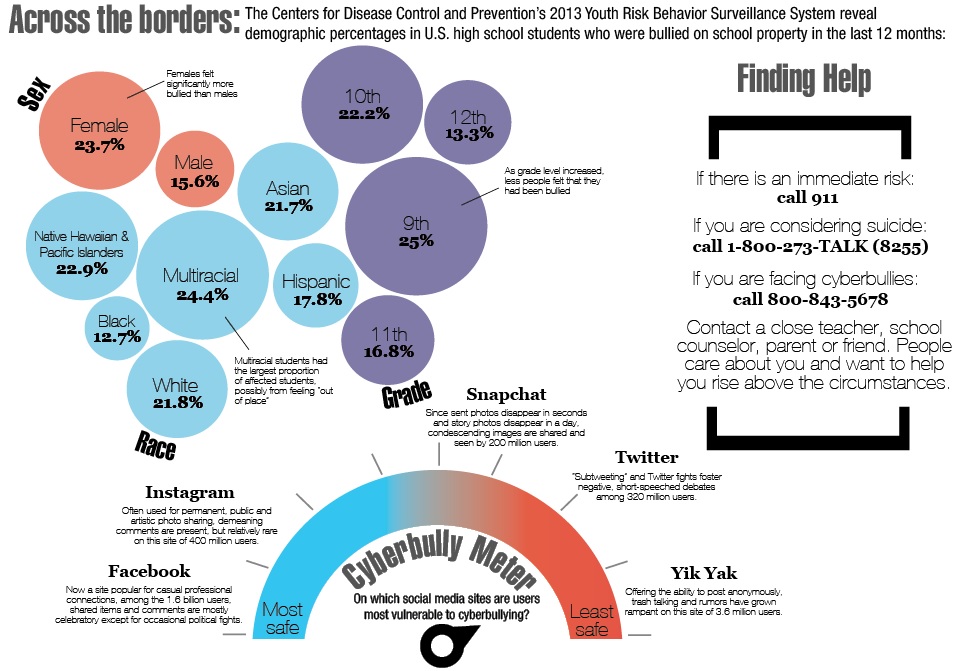Face to face: Removing the mask of bullying
By Lindsay Filgas, Kate Foultz, Caitlin Henderson and Nelson Kappas on May 17, 2016- Tweet
-
- Pin It
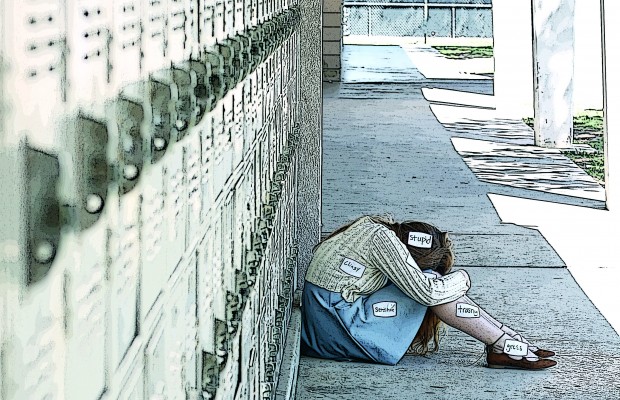
“It was one of those things where playful teasing slowly developed into more psychological abuse and it eventually developed to the point where it got physical,” Jeancarlo Yela, junior, said, describing his past experiences with bullying in elementary school. “I would end up getting beaten almost every day; they would say, ‘Oh if you tell anyone about this we are going to like, break your arms or something,’ and so I was kind of afraid, and I didn’t know what to do, and so I just sat there, and I just ended up taking it for two years until I eventually just left the school.”
Although Yela suffered physically from this violent behavior years ago, the emotional scarring from these events still affects him to this day.
“The lasting effects have been mostly psychological,” Yela said. “I have developed a lot of anxiety and depression both (with) bad luck genetically, and possibly as a result of (the bullying). I have flashbacks all the time. It’s made me afraid of confrontation and interactions with people at times.”
Yela is not alone when it comes to experiencing the trauma and continuing aftermath of bullying. According to DoSomething.org, an organization dedicated to motivating young adults to “take action around social changes,” over 3.2 million students are victims of emotional and physical abuse, with approximately 160,000 teens skipping school everyday to avoid students who bully them or have done so in the past.
Classifying and Handling
“You have to know when there is a line being crossed … every group of friends has playful teasing and horseplay, and that’s one thing,” Yela said. “But if it’s starting to take a toll on your mental state, I think you should know where that line is and make sure it’s not being crossed.”
Joshua Eby, school principal, is also aware of the nuances between bullying and teasing, and tries to clarify how the administration regards these instances.
“I don’t know if it’s bullying at this age level, I look at more of the word ‘harassment,’ or kids bothering other kids,” Joshua Eby, school principal, said. “I just think at this age level, harassment has a different tone to it. So when I tell someone that you are harassing someone, it’s actually more of a legal term, versus bullying which is something that sounds like it happens in elementary school.”
Eby does not hear about all the harassment that occurs on campus, but the cases that are brought to the administration tend to be significant.
“It’s something that the student has tried to cope with on their own, maybe handled with their parents, and at this point it has never stopped. So when we get them, they are pretty serious offenses, and we handle it appropriately,” Eby said.
How the administration handles cases of harassment varies widely depending on the nature of the offense.
“We (enforce) appropriate consequences based upon our district policies or site policies,” Eby said. “If we need to involve law enforcement because we feel it is that egregious, then we will.”
Former head football coach Gary Fabricius knows that team dynamics can be complicated within a large group of competitive athletes of different ages and physical abilities.
“I know in football there is kind of a pecking order with strength and speed, and so sometimes the stronger or quicker guys will sometimes flaunt that in a way. But the guys are very competitive, and even (with) the backups, or … ‘the guys that might be picked on,’ there is still this comradery amongst the team,” Fabricius said.
Despite this, Fabricius is aware that in a high school setting there are bound to be cases of bullying. However, he believes it is often less common with sports teams since the players are voluntarily participating and want a spot on the team, so they will follow the rules put forth by the school and coaches in order to be eligible to play.
“We have leverage because they want to play, whereas on campus they are like ‘What, are you going to kick me out of English? Who cares?’” Fabricius said.
Although Fabricius does not see bullying as a prominent issue on sports teams at the high school, he has had a few players come to him with reports of bullying and stresses the importance of seeking out teacher or adult aid as soon as possible to help resolve the situation.
“We have had an isolated incident where a player … tried to handle (the bullying) themselves (for) probably too long, and then they come and say, ‘he has been picking on me’ and we said ‘why didn’t you come to us sooner?”
In addition to coaches and administration members trying to resolve cases of bullying, peer counselors such as Joshua Horita, junior, also work to solve this issue in addition to helping students with a variety of other social problems.
“Over the 3 years I’ve been doing counseling, I have had 5 counselees (who have been bullied) … I think wherever youth and immaturity is present, bullying will be present since that consideration for others’ point of view is lacking,” Horita said.
Horita explained that one major problem with on campus bullying is that it’s not at the forefront of people’s minds.
“People don’t really think about (bullying) if it’s not affecting them because it’s not a fun thing to think about,” Horita said. “But I think if more people started considering that it is a problem, like if they saw someone having trouble then reaching out is a big thing too … if it’s not a problem for you, then making a difference for someone else (is important).”
The New Face of Harassment
With the increased use of technology, bullying has evolved. Along with physical and verbal harassment, bullying can take place behind the glare of a computer or phone screen.
As stated by stopbullying.gov, “cyberbullying is bullying that takes place using electronic technology,” which can occur through outlets such as “mean text messages or emails, rumors sent by email or posted on social networking sites, and embarrassing pictures, videos, websites, or fake profiles.”
This has proven to be an issue on campus: In an online and on campus poll of 136 NPHS students, about 1 out of 4 said that they have been bullied online.
Maddie Kasper, sophomore, is one of those students. After being harassed in a group text with her classmates, she went to the administration to seek help and found that they were able to resolve her problem.
“I think the school properly handled this because I told my counselor about it, and she told t he students to stop, and they did … (and) they apologized.”
he students to stop, and they did … (and) they apologized.”
While Kasper knows that bullying is still occurring, she believes that many people have pushed the subject out of their mind.
“I think (bullying is) kind of overlooked in a sense,” Kasper said. “When I was younger I know that people talked about it a lot more, but now it’s just kind of overlooked … People don’t talk about it anymore and this is the first I’ve heard of bullying in a super long time.”
Cyberbullying is frequently seen on social media platforms such as Yik Yak, an app through which people can write anonymous messages about their peers. In fall 2015, more than 70 women’s and civil rights groups wrote a letter to the U.S. Department of Education declaring that the app was unsafe, and Yik Yak’s creators soon banned it on all school campuses.
Ariana Bashardoost, senior, has been a victim of cyberbullying for the past 5 years. During her time in high school, the online bullying has transitioned from Facebook to Yik Yak.
“My friends have been sending me screenshots on Yik Yak of people calling me pregnant,” Bashardoost said. “They just keep saying stuff like … ‘Ariana is pregnant, I’m 100% sure’, … ‘she isn’t even attractive though’ (and) …‘she’s definitely gained weight, it’s obvious.’”
Bashardoost tries to not take the comments too personally, as she believes the people who post on the app are simply trying to cause drama.
“It’s just stupid, like people really have nothing better to … (or) talk about, so they just want some form of attention or something exciting,” Bashardoost said.
Bashardoost has made an effort to simply turn a blind eye to the lies that have been spread on the app.
“It really doesn’t bother me … it’s so childish,” Bashardoost said. “I laugh at it because it’s not true. I ignore it (and) … just go on with the day.”
Chloe Diestel, senior, has also been the topic of hurtful comments on Yik Yak over the past year.
“This year I led the Panther Pit, so a lot of people knew who I was and … they would write about me … on things like Yik Yak and just say a bunch of rude comments and make fun of me,” Diestel said.
Diestel recalls that some of the comments referred to her as “loud and annoying” and “the girl with the man voice.”
While Diestel tries to not let rude and hateful comments affect her, she admits it was upsetting.
“Even though I am someone who thinks highly of myself and has good self confidence, it still does just hurt to see those comments,” Diestel said.
For support, Diestel turned to her friends who laughed off the remarks with her and assured her that they weren’t true. Now, she looks back on the event as an opportunity for growth.
“It’s a learning experience, Diestel said. “You’re either going to to use it to get stronger or let them take you down, and I suggest using it to get stronger and remember that later in life when you’re dealing with people who maybe are bullies in person.”
Discrimination and Defamation
Discrimination surrounds the notion that people harassed by others not based on their actions, but simply due to innate differences. On campus, members of the LGBTQ community and students with disabilities have been singled out and harassed based on their identities.
According to the Sexuality Information and Education Council of the United States, 5% of high school students identify as LGBTQ+ (lesbian, gay, bisexual, transgender, questioning, etc.), and 92% of these students experience homophobic remarks in middle or high school.
“I know some kids who have been bullied … for being transgender. Kids who are scared to come out don’t correct people with their pronouns,” Emmett Vanderwier, junior, said. “They’re scared that if they do correct people for their pronouns that they’re going to be further harassed and bullied and made fun of.”
Caden Fransen, senior, has been misgendered and bullied due to his identity as a transgender male.
“People were making fun of me for trying to be masculine … when I had a girlfriend, people would walk by and say ‘Oh they’re lesbians,’” Fransen said. “It hasn’t been like bullying in the traditional sense, it just doesn’t feel good when people are constantly misgendering.”
According to the National Center for Transgender Equality, 75% of transgender youth feel unsafe at school. The Gay Straight Alliance (GSA) focuses to resolve that problem and create a safe environment for LGBTQ+ students on campus.
For their advocacy and support of transgender students, the GSA club at school has become a target of harassment as well.
GSA members hung posters advertising their March 11 event, “Under the Rainbow: A St. Patrick’s Day Dance”, and later saw them vandalized with slanderous terms, insulting the students of the club. Vanderwier recalls one of the posters had writing on it, saying “Satan Squad” and described the act as “ignorant” and “childish.”
Lucia Lemieux, advisor of GSA, addressed the situation with her students.
“I asked the club ‘What do you want to do about it?’ and they felt that bringing attention to it would just make it worse,” Lemieux said. “So we just took it down and chose to not do anything. However if it kept up … then we would probably do something about it.”
In addition to direct attacks on LGBTQ+ students, Lemieux has also noticed indirect forms of discrimination that happen everyday.
“I’ve been known to stop students who … say things like ‘oh that’s so gay.’ I say ‘no that’s not appropriate, we don’t say that.’ That’s like saying ‘that’s so blonde.’ That’s not appropriate,” Lemieux said.
Brandon Janes, English teacher, also provides support to LGBTQ+ students on campus.
“It’s really important that students identify a group of teachers who won’t judge what they believe in and the students feel like they can come in and open up about how they’re feeling,” Janes said.
Lemieux agreed. “I think it’s important for all students to feel a part of the school,” she said. “I feel that because (GSA has) been here, there’s a lot more acceptance on the campus as a whole.”
Another group that has commonly faced harassment is special education students. Because of their different appearance, mental state, and their often inability to defend themselves, they have become easy targets for bullies on many campuses.
Anne Alvarez, special education teacher, explained that she has a special way to deal with those who harass her students.
“If I get a consistent bullier, someone who bullies my kids over and over, I’ll ask that they have to work in my classroom for a whole day so they understand the student’s disabilities, and what they can do to help them rather than hinder them,” Alvarez said.
She explained that after the students actually spend this time with her students, their attitudes change completely.
“(After) a day or two, then they’re my champions, they’re my protectors of my students,” Alvarez said.
However, Alvarez has never actually had to take such action since she has been at NPHS because of how well her students are generally treated by the student body. She stressed that in general, students are very accepting of her students.
“You can feel it, people like my student teacher came from another campus and she said, ‘you just walk on and it’s a really good feeling,’” Alvarez said.

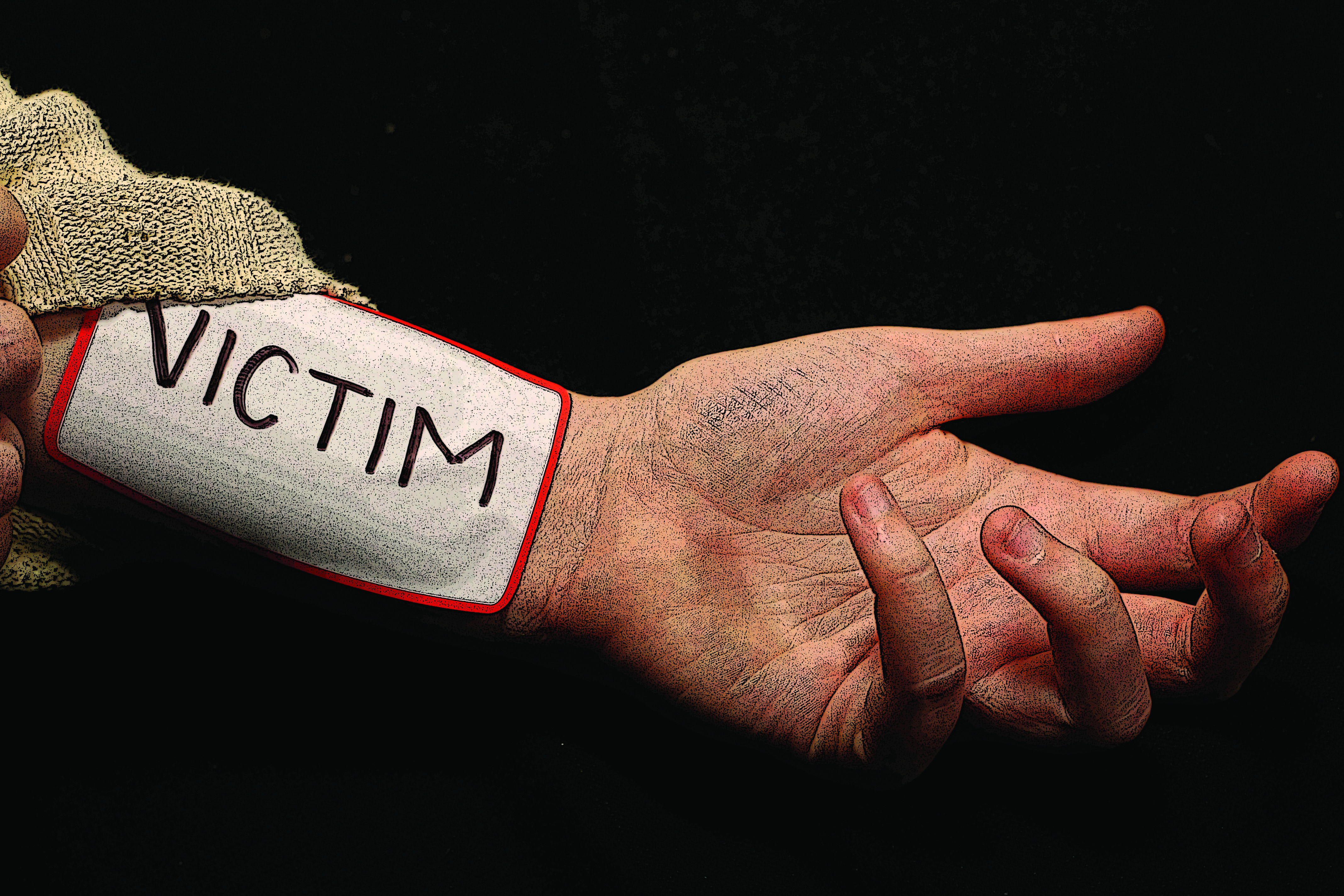

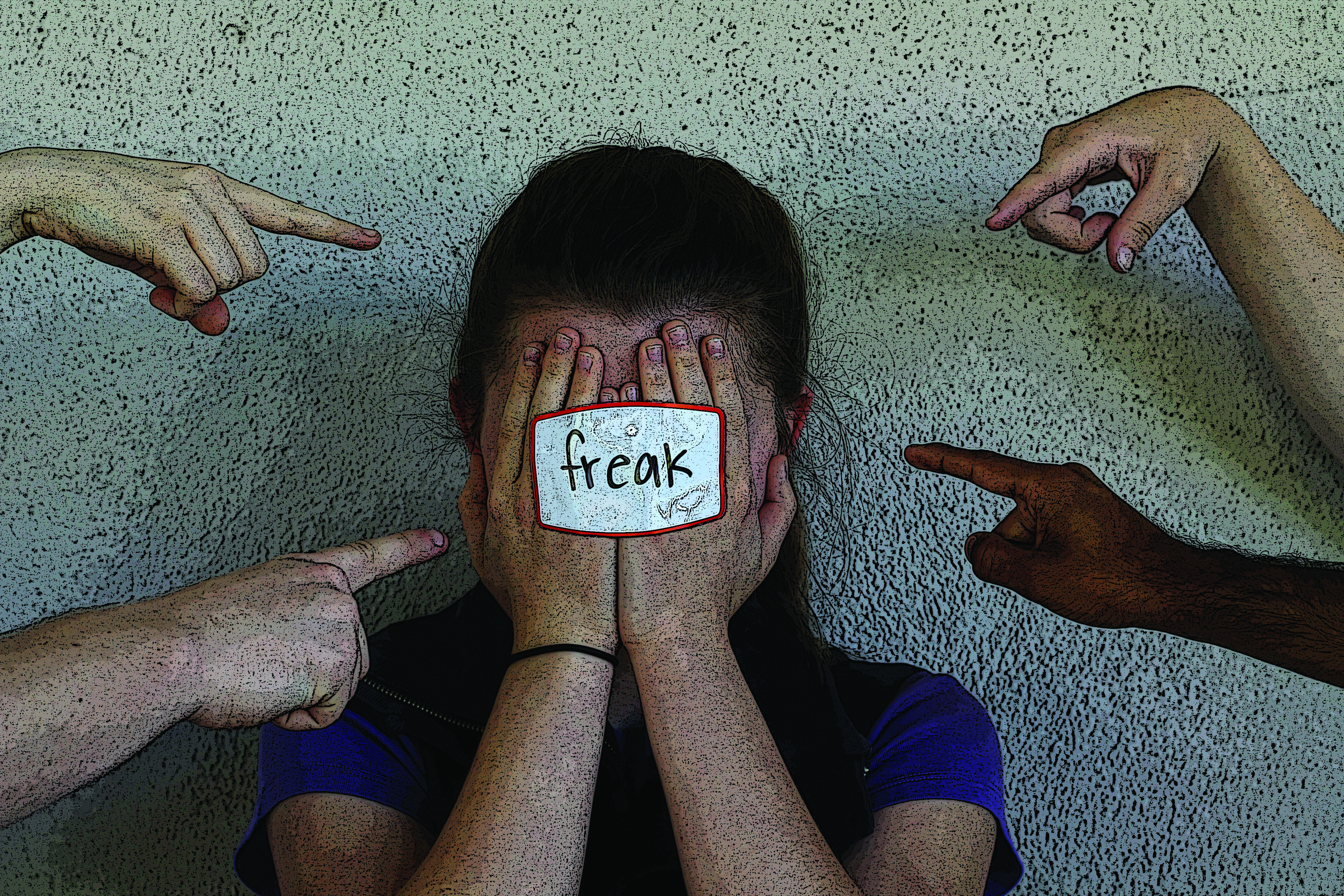

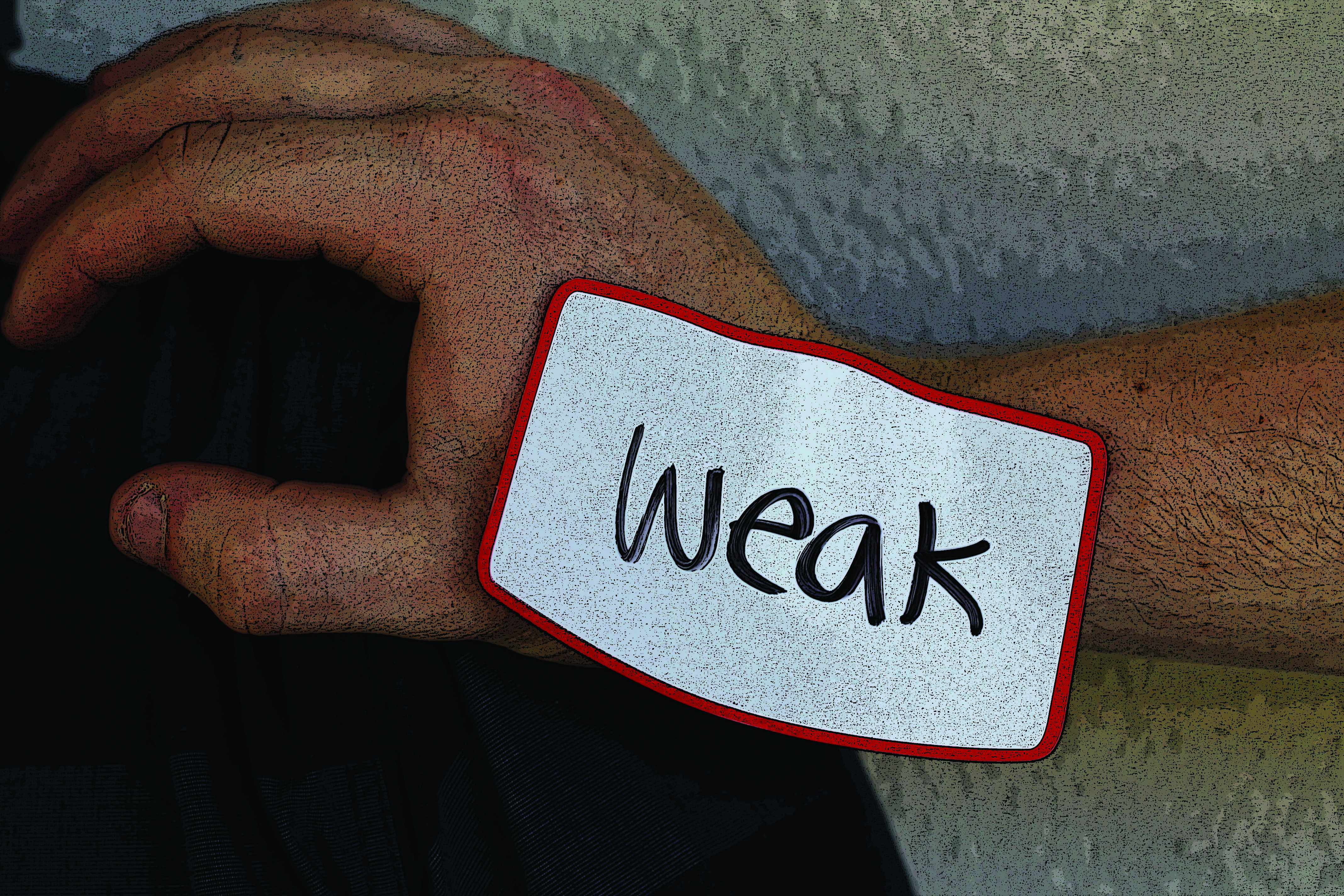
Take a Stand
“I think that people are afraid to speak up because (they think) they’ll get made fun of,” Kasper said. “Bullies can make fun of everything about you, including your talking badly about them.”
John Smith*, junior, has first hand experience with the struggles of deciding when and who to talk to about being bullied. This year, several of his classmates teased him for his weight and called him homosexual slurs. Rather than speaking out he decided to keep the events to himself, which only made the situation more difficult.
“It felt kind of lonely, like no one was on (my) side, and I didn’t really want to bring my parents into this because I was afraid of the repercussions … It’s kinda like you’re stuck between a rock and a hard place, you feel like you don’t have many options,” Smith said.
When he was being bullied, Smith thought that if he involved administration or other adults that would have simply made the problem worse, but in hindsight he just wishes all students know the most important thing is to speak out and seek support and assistance with the situation.
“You shouldn’t be afraid to get help and just have a level head … just don’t be afraid to reach out,” Smith said.
Yela also realizes how vital it is to seek help, even if it is difficult in the moment to do so.
“It’s going to be hard, it’s going to be scary (but do it). I did it too,” Yela said.
You may also like...
Twitter
-
The Latest
-
June 6, 2025
My future isn’t defined by a campus name
-
June 6, 2025
Students address concerns about new deportation policies
-
June 6, 2025
Local fires change the dynamics of communities
-
June 6, 2025
CVUSD faces criticism over sexual assault and harassment
-
June 6, 2025
Navigate religion for yourself, not the people around you
-
June 6, 2025
Ventura County Strawberry Festival proves to be berry successful
-
June 6, 2025
IB Middle Years Programme sparks changes in NPHS academics
-
June 6, 2025
Newcomer Academy shoots for inclusion
-
June 6, 2025
Negligence towards sexual assault reports violates protocol and promotes violence
-
June 6, 2025
Letter from the editors
-
June 6, 2025
The Panther Prowler
The Panther Prowler is the official publication of Newbury Park High School, created and produced by Advanced Journalism students. The Panther Prowler is published every three weeks throughout the school year. Guest letters to the editor are welcome but must be signed.Twitter
Instagram
Copyright © 2014 Panther Prowler.

